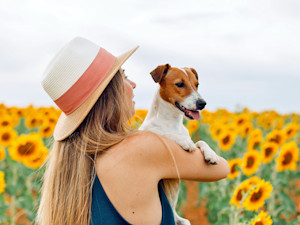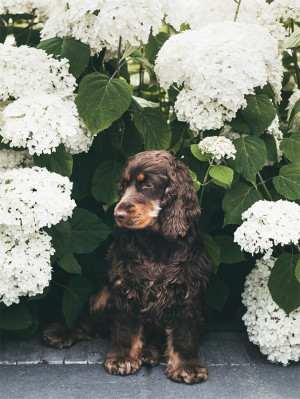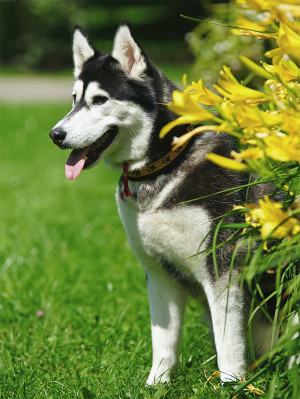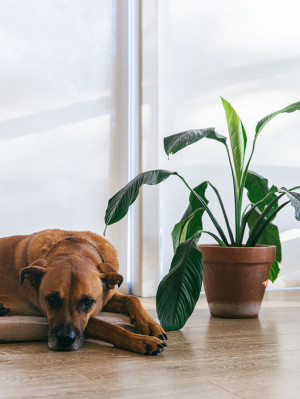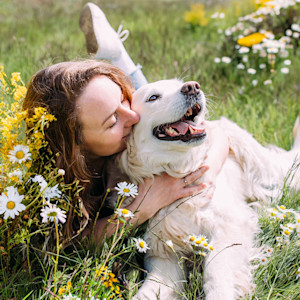What Flowers Are Toxic to Dogs?
Learn how to keep your pup safe in your garden.
The right flowers can brighten up your home and add a touch of nature’s beauty to the interior of your house or apartment. But if you’re a dog parent, you don’t want to bring anything into your home that could present a threat to your pet.
“There are numerous plants and flowers that are potentially toxic to dogs,” Dr. Amy Foxopens in new tab says. “Pet parents should always do their research about plants they’re considering bringing into their home.”
Snap a pic of your pup’s teeth, and GREENIES™ will help you spot potential signs of oral health issues.
Many common flowers, like liliesopens in new tab, daffodils, and hydrangeasopens in new tab, present potential health risks to dogs, so it’s important to be aware of what plants are toxic before you add them to your home or garden. Other toxic flowers include:
Amaryllis belladonna, which can cause vomiting, diarrhea, lethargy, and tremors
Delphinium, also known as larkspur, which can cause neuromuscular effects and vomiting
Cyclamen, which can cause excessive salivation and gastrointestinal symptoms
Hyacinths, which can cause mouth irritation and even breathing difficulties
Ivy, which causes both dermatitis and damage to the gastrointestinal tract
How much do you spend on your pet per year?
Why are some flowers dangerous for dogs?
Some plants and flowers contain toxins that can be dangerous if your dog eats them. This toxicity ranges from mild to severe, depending on the plant. Sometimes a flower will only cause mild mouth irritation or gastrointestinal distress, but in other cases, toxic plants can cause severe and life-threatening symptoms, such as labored breathing or even seizures.
“There are many different reasons a plant may be toxic to dogs,” Dr. Fox says. “This usually comes down to compounds in the plants that cause serious injury to animals when they eat them or come into contact with them.”
What should I do if my dog has eaten a toxic flower?
If you suspect your dog has consumed something toxic, call your vet or animal poison control center immediately. The ASPCA Poison Control Centeropens in new tab at 888-426-4435 and the Pet Poison Helplineopens in new tab at 855-764-7661 are available 24/7.
Diagnosing plant poisoning in dogs
Bring as much information as you can to your vet or the emergency clinic, including what type of plant your dog consumed, how much, and how long ago the incident occurred. Your vet will run tests to determine the best route for treatment. Never induce vomiting in your dog without the explicit permission of your veterinarian.
Symptoms of plant poisoning in dogs
Be aware of the symptoms of plant poisoning in dogs and look out for any of the following symptoms in your pet if you think they may have consumed a toxic plant:
Vomiting or diarrhea
Seizures
Difficulty breathing or rapid breathing
Lethargy
Loss of appetite
Uncoordinated movements
Jaundice (yellowing of the skin or eyes)
Tremors or seizures
Changes in behavior
Treatment
The vet may induce vomiting in your dog to remove the toxins or administer a liquid suspension of activated charcoal, which can help absorb the poison. For more severe cases, intravenous fluids and medications may be required.
How to prevent plant poisoning
The best way to prevent plant poisoning in your dog is to learn which flowers and plants pose a toxic risk. You should also know the symptoms of toxicity, so you can notice immediately if your dog needs medical care from ingesting a poisonous flower. Find ways to keep plants away from your pet and, if possible, keep all potentially toxic plants and flowers out of your home and garden.
Are all parts of a toxic flower poisonous to dogs?
Some flowers are dangerous to dogs regardless of which part they ingest, while others only have toxins in the bulbs, stems, or flowers. Be sure to research which flowers are poisonous to your pets and keep them out of your dog’s reach.
How do I stop my dog from eating toxic flowers?
The best way to prevent your dog from eating potentially poisonous flowers is to keep these plants out of your home. You can also elevate plants with hanging planters or on high shelves out of your dog’s reach or fence off areas of your garden to keep your dog out.
Flowers that are safe for dogs
Fortunately for the plant lover, there are plenty of flowers and plants that are safe for your dog to be around. Choose any of these plants to brighten up your home:
Spider plant
Boston fern
Cat grass
Prayer plant
Maidenhair fern
Ponytail palm
Rosemary
Staghorn fern
Flowers that are dangerous for dogs
Some flowers present a threat to your dog and could cause mild to severe symptoms. Make sure to keep these plants out of your home or at least out of your dog’s reach:
Lily
Tulip
Hyacinth
Geranium
Daffodil
Chrysanthemum
Begonia
Foxglove
Iris
Autumn crocus
The bottom line: Are all plants poisonous for my dog?
Not all plants are poisonous to dogs. In fact, many plants are perfectly safe to have around your beloved pet. Do your research before adding any plants to your home or garden, so you know which plants are safe and which you should avoid entirely.
FAQs (People also ask)
What happens if my dog eats a toxic flower?
Depending on the flower and how much they consume, your dog could experience mild gastrointestinal distress or more serious symptoms like tremors or organ damage. If your dog consumes a toxic plant, contact your vet immediately.
Are toxic flowers poisonous to dogs if they smell them?
For the most part, no. They have to consume the plant to experience any negative effects. However, there are exceptions. However, highly toxic flowers, like lilies, can make dogs sick even if they smell them. This is likely because they get pollen on their nose that they then lick and ingest and this can make them very sick.





